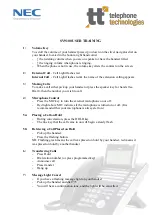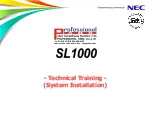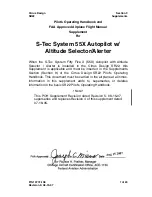
Shows List
Shows can be loaded, saved and edited with the Touch Display in the Shows List view, which can be entered by tapping
the SHOWS LIST button in the top left of the Touch Display when in Active Show view.
Spill Faders
Allow control of legs of a multichannel signal. For example the overall level of 5.1 surround channels is controlled by
a single fader. By using the spill faders, components of the multichannel signal can be altered. If a spill fader is the
currently assigned fader, then processing can also be applied to that component using the assign panels. For a 5.1
channel the legs are broken into the following components: L/R (stereo), C (mono), LFE (mono), LsRs (Stereo).
SRC (Sample Rate Conversion)
A sample rate converter is by default switched in on each AES3 input in the event that an incoming external signal is at a
different sample rate or not synchronised to the same source as the system. It can be switched out if the incoming signal
is known to be synchronous.
Strip User Buttons
Each fader Strip has a vertical arrangement of controls on the surface. In this arrangement are placed 2 user buttons
S1 and S2 which can be assigned to a variety of functions.
Surface
The surface is the physical control surface for a Brio 36 system containing the collection of faders, rotary controllers,
buttons, displays and touchscreen, allowing hands-on control of the audio signals. Also referred to as Console or Desk.
System
The term ‘system’ encompasses the processing core, surface and connected I/O boxes. From the moment a signal enters
an input it is in the system and remains there until it is passed out of an output.
System Logs
Various log files are maintained by different parts of the system. These log files can be collected and transferred to USB
memory for forwarding to Calrec Support in the event that detailed troubleshooting is required.
System Status Monitoring
Calrec’s system for providing information and logs of any developing or occurring faults in the system.
T
Touch Display
Large TFT touchscreen used to operate the Brio 36 surface, including patching, routing, processing and accessing
detailed system settings.
Summary of Contents for BRIO 36
Page 1: ...calrec com Audio Production System with Optional Networking BRIO 36 USER MANUAL V1 1...
Page 12: ...12 BRIO 36 Audio Production System with Optional Networking...
Page 13: ...calrec com BRIO 36 PRODUCT INFORMATION...
Page 20: ...20 BRIO 36 Audio Production System with Optional Networking...
Page 21: ...calrec com BRIO 36 SYSTEM OVERVIEW...
Page 29: ...29 FIGURE 1 BRIO 36 USER INTERFACE DISPLAY...
Page 43: ...calrec com BRIO 36 SETTING UP...
Page 47: ...47 FIGURE 1 SYNCHRONISATION OPTIONS...
Page 67: ...calrec com BRIO 36 GETTING SIGNALS IN AND OUT...
Page 93: ...93 FIGURE 1 THE DIRECT OUTPUT SCREEN...
Page 100: ...100 BRIO 36 Audio Production System with Optional Networking...
Page 101: ...calrec com BRIO 36 PROCESSING...
Page 146: ...146 BRIO 36 Audio Production System with Optional Networking...
Page 147: ...calrec com BRIO 36 MONITORING...
Page 149: ...149 FIGURE 3 EXAMPLE LOUDSPEAKERS SETUP...
Page 155: ...calrec com BRIO 36 METERING...
Page 163: ...calrec com BRIO 36 COMMUNICATIONS...
Page 172: ...172 BRIO 36 Audio Production System with Optional Networking...
Page 173: ...calrec com BRIO 36 ROUTING...
Page 175: ...175 FIGURE 1 CONFIGURING BUSES AND OUTPUTS...
Page 182: ...182 BRIO 36 Audio Production System with Optional Networking...
Page 183: ...calrec com BRIO 36 EXTERNAL INTERFACING...
Page 193: ...calrec com BRIO 36 CONSOLE FACILITIES...
Page 198: ...198 BRIO 36 Audio Production System with Optional Networking...
Page 199: ...calrec com BRIO 36 TERMINOLOGY...
Page 207: ...calrec com BRIO 36 FEATURES BY SOFTWARE VERSION...






































